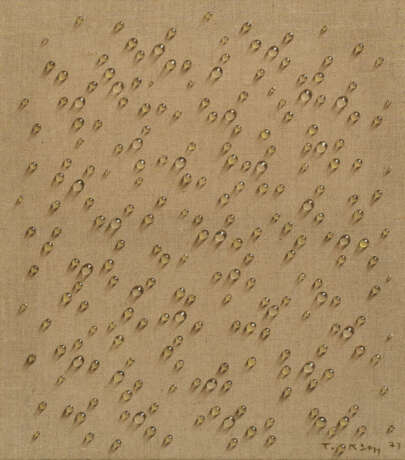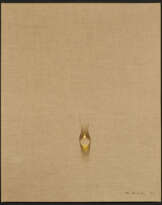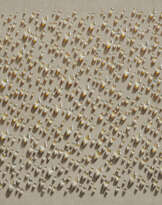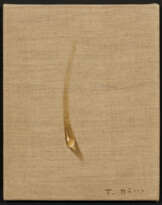ID 952250
Lot 128 | Tschang-Yeul Kim (1929 Maengsan/Korea - 2021 Seoul/Südkorea)
Valeur estimée
€ 55 000 – 95 000
Wassertropfen, Öl auf Leinwand, 55 cm x 46 cm, signiert, 77 datiert, verso auf dem Keilrahmen signiert, 153 nummeriert
Kim Tschang-Yeul gilt neben Nam June Paik und Lee Ufan als einer der bekanntesten zeitgenössischen Künstler Koreas. Er setzte sich seit Beginn seines Schaffens für die Kunst ein, wurde dafür in den "Ordre des Arts et des Lettres" aufgenommen und erhielt 2013 eine Auszeichnung für seine kulturellen Verdienste. Berechtigt, bedenkt man nicht nur sein künstlerisches Schaffen, sondern auch die politischen Gegebenheiten, unter denen er lebte. Dazu gehört das damals japanisch besetzte Korea - das heutige Nordkorea. Nach der Landesteilung wurde er als junger Mann verhaftet und floh nach zehntägiger Haft in das damalige Seoul, das wiederum unter US-Kontrolle stand. Kim Tschang-Yeul studierte Kunst an der Seoul National University. 1958 gründete er die Modern Artists' Association und schloss sich der Informel-Bewegung an, angeführt von Whanki Kim, einem bahnbrechenden abstrakten Künstler Koreas. Die Rockefeller Foundation ermöglichte ihm ein Stipendium, um an der Art Students League of New York zu studieren. Im Anschluss zog Kim Tschang-Yeul nach Paris, wo er bis zu seinem Tod 2021 lebte. Für seine geradezu meditative Auffassung in der Darstellung von Wassertropfen wird Kim Tschang-Yeul weltweit gefeiert. Dabei verwendet der Künstler Abstraktion und Hyperrealismus zugleich, um die feinen Wassertropfen auf der Leinwand darzustellen und eine naturbelassene Ruhe in seinen Werken zu kreieren. Der Künstler erfüllte seine Werke mit den taoistischen Prinzipien seiner Erziehung und charakterisierte Wasser als eine amorphe Einheit, die von der Kraft der Auflösung und Reinigung durchdrungen ist. Die in Feinmalerei gefassten Wassertropfen auf der groben Leinwand scheinen so fragil und gleichzeitig fest montiert zu sein, als ob man sie wie Murmeln vom Bildträger nehmen könnte. Die Herkunft der Tropfen wirft Fragen auf: Sind sie vom Himmel herab auf die Leinwand getropft oder haben sie sich durch die Fasern der Oberfläche gepresst? Ebenso sollte man meinen, dass eine solch raue Oberflächenbeschaffenheit gefährlich für einen natürlichen Wassertropfen sei. Jeder der hier dargestellten zahlreichen Tropfen ist individuell, so wie er es auch in der Natur wäre. Alle werden sie von einer seitlich leicht erhöhter Lichtquelle angestrahlt und schlagen ihren förmigen Schatten in entgegengesetzte Richtung. Dabei scheinen die Stränge der Leinwand durch den transluziden Körper aus Wasser. Ihre feine Beschaffenheit könnte durch die porösen Strukturen aufplatzen oder gar aufgesogen werden und doch halten alle Wassertropfen auf diesem Bild bereits für Jahrzehnte stand. Die Werke von Kim Tschang-Yeul stoßen eine Art Meditation an und so lassen sich aus der Betrachtung Lebensweisheiten ziehen: Der Eine bekannte Wassertropfen, der Wasser zu einem Wellenschlag in Bewegung setzt. Das Wasser, das als Element der Natur das Leben selbst symbolisiert. So auch die Summe unendlich vieler Wassertropfen, die Ozeane ausmachen. All diese Parallelen können auf die Wassertropfen auf der graubraunen Leinwand bezogen werden. Vielleicht nicht verwunderlich, dass sich der Künstler gerade dieses Gestaltungsmittel zu Eigen gemacht hat, wenn man sich seinen Lebensweg dazu ansieht. Er als Künstler, als freier und kreativer Kopf, lebte in einer Welt mit starken Grenzen und politischen Reglements. Doch bleibt der Tropfen bestehen und schenkt dem Betrachter damit nicht nur Freude über die Schönheit eines Wassertropfens, sondern sogar Hoffnung und Zuversicht auf eine bessere Welt.
Tschang-Yeul Kim (1929 Maengsan/Korea - 2021 Seoul/South Korea) Water Drops, oil on canvas, 55 cm x 46 cm, signed, dated 77, signed verso on stretcherframe, numbered 153
Along with Nam June Paik and Lee Ufan, Kim Tschang-Yeul is considered one of Korea's best-known contemporary artists. He has championed the arts since the beginning of his career, was inducted into the Ordre des Arts et des Lettres and received an award for his cultural achievements in 2013. This is justified, considering not only his artistic work, but also the political circumstances in which he lived. This includes the then Japanese-occupied Korea - today's North Korea. After the division of the country, he was arrested as a young man and fled after ten days' imprisonment to what was then Seoul, which in turn was under US control. Kim Tschang-Yeul studied art at Seoul National University. In 1958, he founded the Modern Artists' Association and joined the Informel movement, led by Whanki Kim, a pioneering Korean abstract artist. The Rockefeller Foundation provided him with a scholarship to study at the Art Students League of New York. Kim Tschang-Yeul then moved to Paris, where he lived until his death in 2021.
Kim Tschang-Yeul is celebrated worldwide for his almost meditative approach to depicting water drops. The artist uses abstraction and hyperrealism at the same time to depict the fine drops of water on the canvas and create a natural calm in his works. The artist infused his works with the Taoist principles of his upbringing, characterising water as an amorphous entity imbued with the power of dissolution and purification. The water drops on the rough canvas, set in fine painting, seem so fragile and at the same time firmly mounted, as if they could be removed from the picture support like marbles. The origin of the drops raises questions: Did they drip down from the sky onto the canvas or did they squeeze through the fibres of the surface? Likewise, one would think that such a rough surface texture would be dangerous for a natural drop of water. Each of the numerous drops depicted here is individual, just as it would be in nature. All of them are illuminated by a light source slightly elevated from the side and cast their shaped shadows in opposite directions. In the process, the strands of the canvas shine through the translucent body of water. Their fine texture could burst or even be absorbed by the porous structures, and yet all the drops of water on this painting have already withstood for decades.
Kim Tschang-Yeul's works trigger a kind of meditation, and so life lessons can be drawn from their contemplation: The One familiar drop of water that sets water in motion to create a ripple. Water, as an element of nature, symbolises life itself. So too the sum of infinite water drops that make up oceans. All these parallels can be related to the water drops on the grey-brown canvas. Perhaps it is not surprising that the artist has made this very means of design his own, if one looks at his life's journey in this regard. He as an artist, as a free and creative mind, lived in a world with strong borders and political regulations. Yet the drop remains and thus gives the viewer not only joy at the beauty of a drop of water, but even hope and confidence in a better world.
| Artiste: | Tschang-Yeul Kim (1929 - 2021) |
|---|---|
| Catégorie maison de vente aux enchères: | Peinture des 19e et 20e siècles |
| Artiste: | Tschang-Yeul Kim (1929 - 2021) |
|---|---|
| Catégorie maison de vente aux enchères: | Peinture des 19e et 20e siècles |
| Adresse de l'enchère |
WETTMANN Luxusuhren Bredeneyer Straße 119-121 45133 Essen Allemagne | ||||||||||||||
|---|---|---|---|---|---|---|---|---|---|---|---|---|---|---|---|
| Aperçu |
| ||||||||||||||
| Téléphone | +4920185785190 | ||||||||||||||
| Fax | +49 (0)208 439 17 35 | ||||||||||||||
| Commission | 14,28% | ||||||||||||||
| Conditions d'utilisation | Conditions d'utilisation | ||||||||||||||
| transport |
Service postal Service de messagerie ramassage par vous-même | ||||||||||||||
| Modes de paiement |
Virement bancaire | ||||||||||||||
| Heures d'ouverture | Heures d'ouverture
|














